|
Intention of this Rule:
The Checking From Behind (CFB) rule was
introduced because people saw a need to protect hockey players from severe
head, neck and back injuries. The most severe of these injuries being
death or paralyzed for life. Checking from behind has been around since
hockey has been played on ponds but not until recently has this issue been
looked at seriously. This need to enforce this rule arose in part by the
lack of respect for an opponent’s well being that is shown in almost
every hockey game.
The number of people who are injured
because of checks from behind has decreased over the last couple of years
because the Canadian Hockey Association saw a need to try and eliminate
this cowardly act from the game of hockey, and accordingly they introduced
the ‘Checking From Behind’ penalty to combat this problem.
Checking from Behind has three possible
calls that can be made by the Referee,
1) Minor penalty
+ Game Misconduct (GM)
2) Major penalty + Game
Misconduct (GM)
3) Match penalty
Regardless of what call is made, any player
who, in the judgement of the Referee, checks a player from behind will be
removed from that game and pending the ruling of the governing bodies of
that league, possibly for more games.
Linesmen are allowed to call Game
Misconduct penalties throughout the course of a hockey game. However,
since they are not allowed to call any minor penalties, they cannot call a
Minor penalty plus a Game Misconduct for checking from behind.
Nevertheless, if hockey is looking to eliminate the Checking From Behind
once and for all, they should look at allowing Linesmen to make this call.
The only reason why this may not occur is because linesmen are usually not
as qualified as the Referees and they may not have the experience to make
a judgement on a Check from Behind.
Players beware! If a linesman sees a Check
from Behind calling for a Major + Game Misconduct or a Match penalty, then
they are allowed to report this to the referee who will then either call a
Major + Game Misconduct, Match penalty, or make no call at all. But for
the most part, if a linesman feels the need to report a Check from Behind
to the referee then there must be sufficient reason to assess the player a
Major + GM or a Match penalty.
Referee’s Judgement
A referee must consider the following
factors in making his decision with regards to Checking From Behind:
1) Did the player
throwing the check mean to hit the player from behind?
Not surprisingly, an experienced Referee
will always have a gut feeling as to whether or not a player making the
check wanted to hit his opponent directly from behind or whether or not
there was an attempt to injure. This feeling will directly reflect the
call (Minor + GM, Major + GM or Match). If the Referee feels that it was
an accident then he may lean towards the Minor + GM for Checking From
Behind.
2) Did the hit
occur on the side of the shoulder and cause the player to spin into the
boards as though he was checked from behind?
Quite often players will hit an opponent on
the side of the shoulder and this will send the player into the boards
awkwardly. Coaches and fans dispute these hits the most, but the key is
that the check never actually occurred from behind. It was the way that
the player being hit went into the boards that made it look as though he
was checked from behind. If in the Referee’s opinion, the player
receiving the check was hit legally and it was the way that he went into
the boards that made it look like a check from behind, the Referee will
either not call a penalty or he may assess a minor for boarding if he
feels that the player throwing the check wanted to violently throw his
opponent into the boards.
|
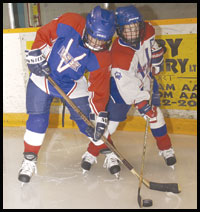
|
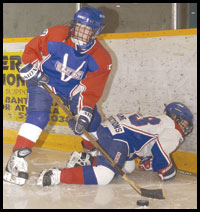
|
|
As point #2
states, the check is shoulder to shoulder but the end result has a
player going into the boards in an awkward position. The check was
perfectly legal but the end result looks as though there was a check
from behind. |
3) Did the player being hit turn at the
last second? (this is still a penalty for Checking from Behind), but it
may change a Major to a Minor penalty.
Remember that if a player about to be
checked turns at the last second and is hit from behind then the player
throwing the check will still be assessed a penalty for Checking from
Behind.
Referees are aware of players who always
turn their backs when they are about to be hit, especially after the Ref
has seen the player over a few games. These players will rarely suck a
player into receiving a CFB penalty once the Referee is used to these
players’ tendencies. Furthermore, if the referee feels that the player
who turned at the last second did so on purpose and he gets injured, there
is a very good chance that the player being assessed the penalty, will not
receive a Major penalty plus a Game Misconduct.
|
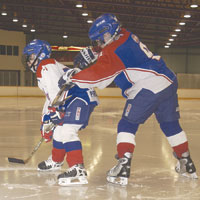
|
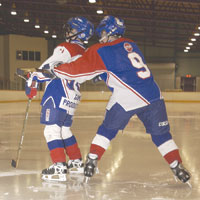
|
|
In these two
photos, you see what commonly happens in front of the net. Both the
Forward (white) and the Defence (blue) are battling for postion. The
defenceman throws a cross-check into the forward’s lower back.
This is not a Check From Behind because the Defenceman was not in
motion. |
4) Was the player throwing the check in
motion or standing still?
You will often see a player skating
backwards and run into a player that is standing still causing the player
skating backwards to fall to the ice and his head to snap back. This is
not a check from behind because the player standing still did not check
the player; he was just standing his ground.
Another situation is when two players are
standing in front of the net battling for position. The defenceman will
usually throw a few cross-checks to the back of the opposing player
causing this player to fall to the ice. This is not a check from behind
because the player throwing the cross-check was not in motion, however he
can still receive a penalty for cross-checking.
5) Was there unintentional contact made to
the back of a player while players were battling for the puck?
This happens quite often throughout a game
where two players are battling for the puck along the boards. Usually the
forward is trying to shield the puck from the defender by using his body
(keep puck by boards, then his body about 3 or 4 feet away from the puck
and then the defender). The defender will sometimes make contact with the
back of the forward as he is trying to get the puck and this sometimes
sends the forward into the boards head first. This is a judgement call for
the referee to make. Since the defending player is usually not in motion
it is tough to call a checking from behind penalty so referees will either
call nothing and let play continue or they will assess the defending
player with a boarding penalty just to say that they made a call when a
player went head first into the boards.
This boarding call is a way for the referee
to calm down the team whose player just went head first into the boards
and it also calms the defending player’s team because their player did
not get kicked out of the game.
6) Was the player who received the check
able to protect himself?
This factor will determine if a minor,
major or match penalty will be assessed.
If the player being checked from behind can
get his arms up in a manner that will help slow himself down or protect
his head from hitting the boards first, then you will usually see a minor
penalty called instead of a major.
If a player goes into the boards or net and
is unable to get his arms up above his head and the head makes contact
with the boards or net first then the referee will usually go to a Major
or Match penalty due to the degree of violence that the player went into
the boards/net.
|
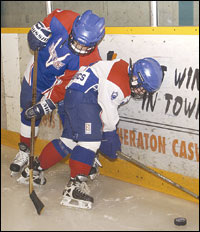
|
|
The above photo
relates to point #6. This player being checked from behind was
unable to get his arms up against the boards &/or glass in order
to protect his head &/or shoulder from contacting the boards
first. When a check from behind like this one occurs and an injury
occurs, a referee may lean towards a more severe penalty such as a
Match penalty instead of the Major penalty plus a Game Misconduct. |
7) Was the check in open ice or into the
boards (distance to boards) or net?
An open ice check from behind is not quite
as serious as a check into the boards where the player comes to a sudden
stop. This is because you will see the player checked from behind continue
to slide down the ice and no injury usually results from an open ice
check. The injury that is most common from an open ice check from behind,
is to the neck of the player being hit because his neck snaps back as
though he was just rear-ended in a car accident.
A player going into the boards or net who
is not able to protect himself will usually result in a Major + GM or
Match penalty being called. This is because the neck and spine are more
susceptible to a break when the top of the head hits the boards, thus
stopping the head while the rest of the body continues its momentum into
the boards squeezing the vertebrae and resulting in a break if the impact
was hard enough.
8) Did the players neck snap back or was it
a light hit? Position of head:
If the players head snapped back after the
check from behind then the referee is more likely to assess a CFB penalty
because the players neck snapping back shows that there was some excessive
force being used, causing the neck to snap back.
When a player goes into the boards head
first the referee will look to see if the top of the head, the players
face, or the back or side of the head hit the boards first. Obviously
hitting the top of the head first creates a greater opportunity for injury
to the whole spine as opposed to hitting your face or the back of your
head which puts more chance of injury to the neck.
Regardless of the position of the head
going into the boards, a checking from behind penalty should be called.
The position of the head and the speed of the player going into the boards
will determine what the Referee assesses. The faster and closer to the top
of the head, the greater the chance that the penalty will be a Major or
Match penalty.
|
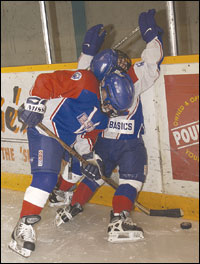
|
|
When a player is
plastered up against the boards causing his head to snap back and
his back to bend in a "U" shape, there is a good chance
that a penalty may be assessed if the official was able to see the
check. |
9) Did the player making the check try to
catch or hold the player up as he was making the check?
Most coaches teach their players that if
they are about to hit a player from behind then they should try to grab
hold of the player in an attempt to slow the player down as he goes into
the boards. This is because if a referee sees that you made an attempt to
try to stop the player from going into the boards head first then the
Referee is more likely to give a lighter penalty to you if he assesses one
at all.
If a referee sees that a player did not
mean to drive a player from behind into the boards or in the open ice then
there is less chance that this player will receive a penalty or at the
very least he may not be assessed a severe penalty.
10) Did the player throw himself into the
boards trying to draw a penalty?
Parents, coaches, players, and Referees
have all seen players after being touched in the back, throw themselves
into the boards. This sounds crazy but there are players who will do
anything to try and get a power play, even if it means putting your neck
on the line (no pun intended!).
If a referee notices this occur then there
is most likely not going to be a penalty assessed against a player who did
not mean to check a player from behind. Especially if the player being
tapped makes a mockery of the game by throwing himself into the boards.
So, don’t get mad at the Referee when you see this, get mad at the
player for putting his own health at risk.
11) Was the check in the middle of the back
or on the side of the back?
A key factor that will determine if a
penalty for checking from behind is called is whether or not the player
was checked in the middle of the back or towards the outer edges of the
back (away from the spine).
The closer a player is checked near the
sides of the body even though the hit was in the back region, the less
chance that a player will receive a checking from behind penalty. This is
because a Referee does not want to kick a player out of the game unless he
is absolutely sure that the player committing the infraction deserved a
game misconduct.
12) The player is injured so why wasn’t a
Major + Game Misconduct called?
You must remember that even though the rule
states that as soon as a player is injured the player causing the injury
must receive a Major plus a Game Misconduct, this does not happen because
of the point made in #11.
If a Referee is unsure as to whether or not
a player is actually hurt or if the Referee feels that the player will not
miss a shift then the Referee may not assess the Major + GM but may go to
the Minor penalty plus a Game Misconduct.
The key factor with regards to if a Referee
will assess a minor, major or match penalty is the severity of the hit,
not the actual injury (if any injury results) that may result.
Summary
When a person looks at what a Referee must
consider when deciding to assess a Minor + GM, Major + GM, or a Match
penalty, you must realize that it is not an easy call to make, especially
when referees don’t have the luxury of using various video angles and
minutes to analyze a possible check from behind. Referees have a split
second to factor in all the above points and make their decision.
OHL Rule
In the OHL and other upper leagues this
rule is slightly modified because these leagues are no longer at the minor
hockey level, they are now in the amateur/professional leagues. The minor
hockey associations try to protect their participants to a greater extent
and thus they create stricter penalties to provide this protection.
As for the OHL, the Checking From Behind
penalty is slightly modified. Here are the 4 types of CFB penalties
instead of 3 types in minor hockey.
1) Minor penalty (No
GM)
2) Double Minor penalty (No
GM)
3) Major penalty + GM
4) Match penalty
The differences are that with a minor
penalty for checking from behind there is no game misconduct as in the
minor hockey leagues. Also, if the referee was going to assess a minor
penalty for checking from behind and the player turned at the last second
and was injured, then the referee has the option to assess a double minor
penalty with no game misconduct instead of a Major penalty plus a Game
Misconduct. |
